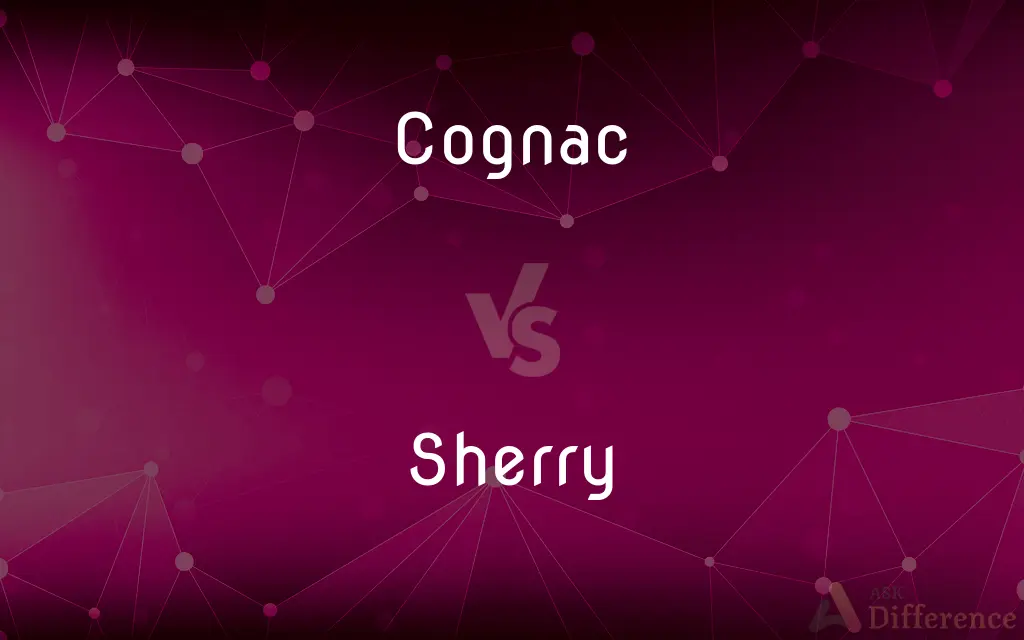Cognac vs. Sherry — What's the Difference?
Edited by Tayyaba Rehman — By Fiza Rafique — Updated on April 3, 2024
Cognac is a type of brandy made from grapes in the Cognac region of France, known for its double distillation process, while Sherry is a fortified wine from the Jerez region of Spain, notable for its variety of styles from dry to sweet.

Difference Between Cognac and Sherry
Table of Contents
ADVERTISEMENT
Key Differences
Cognac, originating from the Cognac region in France, is a luxurious spirit distilled from white grapes. It undergoes a meticulous double distillation process in copper pot stills and is aged in French oak barrels, contributing to its rich flavor profile that includes notes of fruit, spice, and oak. The aging process is crucial for Cognac, with classifications such as VS (Very Special), VSOP (Very Superior Old Pale), and XO (Extra Old) indicating the minimum age of the youngest brandy in the blend. Sherry, on the other hand, is a fortified wine from the Jerez region in southern Spain, known for its unique production process that includes fortification with grape spirit after fermentation. Sherry comes in a variety of styles, ranging from dry versions like Fino and Manzanilla, which are light and crisp, to sweet varieties such as Pedro Ximénez and Cream Sherry, which are rich and sugary. The solera system, a method of blending and aging Sherry in barrels, ensures consistency and complexity of flavor.
While both Cognac and Sherry are celebrated for their depth of flavor and heritage, their production methods and base ingredients significantly differ. Cognac's exclusivity comes from its geographic designation and distillation process, making it a distilled spirit. Sherry's diversity is rooted in its aging process and the fortification stage, classifying it as a wine, albeit fortified.
Cognac's flavor is influenced heavily by its aging process in oak barrels, which imparts vanilla, caramel, and spice notes. Sherry's flavor profile, however, varies widely depending on the type; Fino Sherry offers almond and green apple notes, while Pedro Ximénez is known for its raisin and fig characteristics.
In terms of consumption, Cognac is often enjoyed as a digestif, savored slowly to appreciate its complex flavors, while Sherry can be versatile, serving as an aperitif in its dryer forms or as a dessert wine in its sweeter styles. This versatility makes Sherry a popular choice for pairing with a wide range of foods, from tapas and seafood to rich desserts.
Comparison Chart
Base Ingredient
White grapes
White grapes (primarily Palomino, Pedro Ximénez, Moscatel)
ADVERTISEMENT
Origin
Cognac region, France
Jerez region, Spain
Production Process
Double distillation in copper pot stills, aged in French oak barrels
Fermented, then fortified with grape spirit, aged in barrels using the solera system
Classification/Types
VS, VSOP, XO based on aging
Fino, Manzanilla, Amontillado, Oloroso, Pedro Ximénez, Cream based on sweetness and aging
Flavor Profile
Fruit, spice, oak, vanilla, caramel
Ranges from dry and light (Fino) to sweet and rich (Pedro Ximénez)
Consumption
Often as a digestif
Versatile: as an aperitif or dessert wine depending on the style
Alcohol Content
Generally 40% ABV
15-22% ABV depending on the style
Compare with Definitions
Cognac
Distilled from white grapes and aged in oak barrels.
The Cognac had developed a complex flavor from years in oak.
Sherry
Varied in style from dry to sweet.
For dessert, they chose a sweet Pedro Ximénez Sherry.
Cognac
A type of brandy from the Cognac region of France.
He savored a glass of XO Cognac by the fireplace.
Sherry
Often paired with food.
Manzanilla Sherry is perfect with seafood.
Cognac
Enjoyed worldwide as a premium spirit.
The gift of a fine Cognac was received with great appreciation.
Sherry
Ranges in alcohol content.
The Oloroso Sherry had a higher alcohol content, making it a robust choice.
Cognac
Known for its strict production standards.
Authentic Cognac must meet rigorous criteria set by French law.
Sherry
Produced using the solera system.
The solera system gives Sherry its unique blend of flavors.
Cognac
Classified by age.
VSOP Cognac is aged for at least four years.
Sherry
A fortified wine from the Jerez region of Spain.
They began their meal with a chilled glass of Fino Sherry.
Cognac
Cognac ( KON-yak, also US: KOHN-, KAWN-, French: [kɔɲak] (listen)) is a variety of brandy named after the commune of Cognac, France. It is produced in the surrounding wine-growing region in the departments of Charente and Charente-Maritime.
Sherry
Sherry (Spanish: Jerez [xeˈɾeθ]) is a fortified wine made from white grapes that are grown near the city of Jerez de la Frontera in Andalusia, Spain. Sherry is produced in a variety of styles made primarily from the Palomino grape, ranging from light versions similar to white table wines, such as Manzanilla and fino, to darker and heavier versions that have been allowed to oxidise as they age in barrel, such as Amontillado and oloroso.
Cognac
A high-quality brandy, strictly speaking that distilled in Cognac in western France
We went to a bar and had some cognac
A good range of cognacs
Sherry
A fortified Spanish wine ranging from very dry to sweet and from amber to brown.
Cognac
A brandy distilled from white wine and produced in the vicinity of Cognac.
Sherry
A similar wine made elsewhere.
Cognac
A brandy distilled from white wine in the region around Cognac in France.
Major manufacturers add a small proportion of caramel to color their cognacs.
Sherry
(uncountable) A fortified wine produced in Jerez de la Frontera in Spain, or a similar wine produced elsewhere.
Cognac
A kind of French brandy, so called from the town of Cognac.
Sherry
A variety of sherry.
They produce several quality sherries.
Cognac
High quality grape brandy distilled in the Cognac district of France
Sherry
A glass of sherry.
Would you like a sherry?
Sherry
A Spanish light-colored dry wine, made in Andalusia. As prepared for commerce it is colored a straw color or a deep amber by mixing with it cheap wine boiled down.
Sherry
Dry to sweet amber wine from the Jerez region of southern Spain or similar wines produced elsewhere; usually drunk as an aperitif
Common Curiosities
Is Sherry considered a wine or a spirit?
Sherry is considered a fortified wine because it is made from fermented grape juice that is then fortified with grape spirit.
Why is the solera system important in Sherry production?
The solera system allows for continuous blending and aging, ensuring consistency and complexity of flavor across batches.
What does the term 'VSOP' in Cognac signify?
VSOP (Very Superior Old Pale) indicates that the youngest Cognac in the blend has been aged for at least four years.
What food pairs well with dry Sherry?
Dry Sherry like Fino or Manzanilla pairs well with almonds, olives, ham, and seafood.
How long can Cognac be aged?
Cognac can be aged for decades, with some of the finest examples being aged for over 50 years.
Can Sherry only be produced in Spain?
Yes, authentic Sherry can only be produced in the Jerez region of Spain, protected by designation of origin.
Can Cognac and Sherry be used in cooking?
Yes, both can be used to add depth and flavor to a variety of dishes, from sauces and marinades to desserts.
Are there health benefits to drinking Sherry in moderation?
Moderate consumption of Sherry, like red wine, has been associated with cardiovascular benefits due to its antioxidant content.
What makes Cognac different from other brandies?
Cognac is distinguished by its geographic origin, specific grape varieties, double distillation process, and aging in French oak.
How should Cognac be served?
Cognac is best served at room temperature, often in a tulip glass to concentrate its aromas.
What makes Sherry sweet?
Sweet Sherry, such as Pedro Ximénez, is made from grapes that have been sun-dried to concentrate their sugars.
What is the best occasion to enjoy Sherry?
Sherry is versatile and can be enjoyed as an aperitif, with a meal, or as a dessert wine, depending on its style.
How is Cognac classified?
Cognac is classified based on age: VS (aged at least 2 years), VSOP (4 years), and XO (10 years).
How does the alcohol content in Cognac compare to Sherry?
Cognac generally has a higher alcohol content (around 40% ABV) compared to Sherry (15-22% ABV).
Why is Cognac considered a luxury spirit?
Its meticulous production process, aging, and the prestige associated with the Cognac region contribute to its luxury status.
Share Your Discovery

Previous Comparison
Ton vs. Tonnage
Next Comparison
Transfection vs. TransformationAuthor Spotlight
Written by
Fiza RafiqueFiza Rafique is a skilled content writer at AskDifference.com, where she meticulously refines and enhances written pieces. Drawing from her vast editorial expertise, Fiza ensures clarity, accuracy, and precision in every article. Passionate about language, she continually seeks to elevate the quality of content for readers worldwide.
Edited by
Tayyaba RehmanTayyaba Rehman is a distinguished writer, currently serving as a primary contributor to askdifference.com. As a researcher in semantics and etymology, Tayyaba's passion for the complexity of languages and their distinctions has found a perfect home on the platform. Tayyaba delves into the intricacies of language, distinguishing between commonly confused words and phrases, thereby providing clarity for readers worldwide.
















































